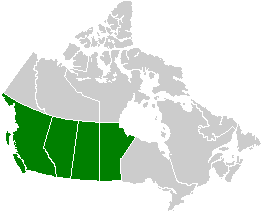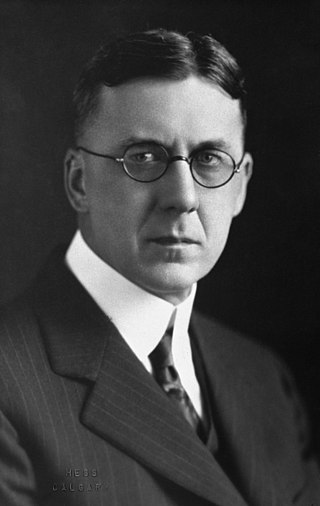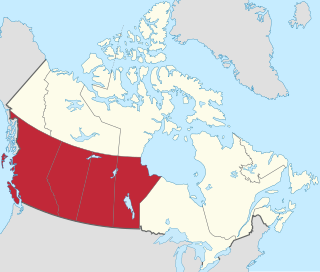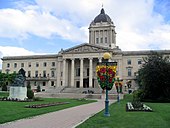The British North America Acts 1867–1975 are a series of Acts of Parliament that were at the core of the constitution of Canada. Most were enacted by the Parliament of the United Kingdom and some by the Parliament of Canada. In Canada, some of the acts were repealed in Canada by the Constitution Act, 1982. The rest were renamed the Constitution Acts and amended, with those changes only having effect in Canada. The Canadian versions of the Constitution Acts make up the Constitution of Canada, and can only be amended in Canada.
Canadian federalism involves the current nature and historical development of the federal system in Canada.
The Dominion Land Survey is the method used to divide most of Western Canada into one-square-mile (2.6 km2) sections for agricultural and other purposes. It is based on the layout of the Public Land Survey System used in the United States, but has several differences. The DLS is the dominant survey method in the Prairie provinces, and it is also used in British Columbia along the Railway Belt, and in the Peace River Block in the northeast of the province.

The Saskatchewan Act, S. C. 1905, c. 42. is an Act of the Parliament of Canada which established the new province of Saskatchewan, effective September 1, 1905. Its long title is An Act to establish and provide for the government of the Province of Saskatchewan. The Act received royal assent on July 20, 1905. The Saskatchewan Act is part of the Constitution of Canada.

The Dominion Lands Act was an 1872 Canadian law that aimed to encourage the settlement of the Canadian Prairies and to help prevent the area being claimed by the United States. The Act was closely based on the U.S. Homestead Act of 1862, setting conditions in which the western lands could be settled and their natural resources developed.

The Alberta Act, effective September 1, 1905, was the act of the Parliament of Canada that created the province of Alberta. The Act is similar in nature to the Saskatchewan Act, which established the province of Saskatchewan at the same time. Like the Saskatchewan Act, the Alberta Act was controversial because it allowed the Government of Canada to maintain control of all of Alberta's natural resources and public lands. Alberta did not win control of these resources until the passage of the Natural Resources Acts in 1930.

Alberta's Métis people are descendants of mixed First Nations/Indigenous peoples and White/European families. The Métis are considered an aboriginal group under Canada's Constitution Act, 1982. They are separate and distinct from First Nations, though they live in the same regions and have cultural similarities, and have different legal rights.
The Peace River Block is an 3,500,000-acre (14,000 km2) area of land located in northeastern British Columbia, in the Peace River Country. In exchange for building a rail line across Canada to British Columbia, the Canadian Pacific Railway was given the Railway Belt, 20 miles (32 km) of land on each side of the rail. To compensate the CPR for alienated or non-arable land in the 40-mile (64 km) wide strip, the Province allowed the Dominion government to take control of 3,500,000 acres (14,000 km2) within B.C., northeast of the Rocky Mountains. This arrangement passed the provincial legislature on December 19, 1883, and passed the Dominion house on March 21, 1884, as the "Settlement Act". As all the land northeast of the Rocky Mountains became a provincial reserve pending the Dominion government's decision on what land to select prevented homesteading and land claims. After several surveys of the land the Dominion government took possession in 1907. The land the Dominion government chose was an approximately square-shaped block of land 72.4 miles (116.5 km) north-south and 75.7 miles (121.8 km) east-west. The south boundary begins at the intersection of the Alberta-British Columbia border and the Twentieth Baseline of the Dominion Land Survey and the north boundary begins at the Twenty-third Baseline, however both boundaries are run at right angles to the Alberta-British Columbia Border without accounting for meridian convergence and thus deviate south of each baseline. Land within the block was initially surveyed using the 3rd and 4th Systems of the Dominion Land Survey however much of the south and west parts of the block were eventually surveyed into district lots similar to other parts of British Columbia.

Western alienation, in Canadian politics, is the notion that the Western provinces – British Columbia, Alberta, Saskatchewan and Manitoba – have been alienated, and in some cases excluded, from mainstream Canadian political affairs in favour of Ontario and Quebec. Western alienation claims that these latter two are politically over-represented and economically favoured, which has given rise to the sentiment of alienation among many western Canadians.

The monarchy of Canada forms the core of each Canadian provincial jurisdiction's Westminster-style parliamentary democracy, being the foundation of the executive, legislative, and judicial branches of government in each province. The monarchy has been headed since September 8, 2022 by King Charles III who as sovereign is shared equally with both the Commonwealth realms and the Canadian federal entity. He, his consort, and other members of the Canadian royal family undertake various public and private functions across the country. He is the only member of the royal family with any constitutional role.

Canada has access to all main sources of energy including oil and gas, coal, hydropower, biomass, solar, geothermal, wind, marine and nuclear. It is the world's second largest producer of uranium, third largest producer of hydro-electricity, fourth largest natural gas producer, and the fifth largest producer of crude oil. In 2006, only Russia, the People's Republic of China, the United States and Saudi Arabia produce more total energy than Canada.
Crown corporations in Canada are government organizations with a mixture of commercial and public-policy objectives. They are directly and wholly owned by the Crown.
Land ownership in Canada is held by governments, Indigenous groups, corporations, and individuals. Canada is the second-largest country in the world by area; at 9,093,507 km² or 3,511,085 mi² of land it occupies more than 6% of the Earth's surface. Since Canada uses primarily English-derived common law, the holders of the land actually have land tenure rather than absolute ownership. The Crown is given permission to hold land by treaty granted by the Indigenous people of Canada.

The 6th Alberta Legislative Assembly was in session from February 10, 1927, to May 10, 1930, with the membership of the assembly determined by the results of the 1926 Alberta general election held on June 28, 1926. The Legislature officially resumed on February 10, 1927, and continued until the fourth session was prorogued on April 3, 1930 and dissolved on May 10, 1930, prior to the 1930 Alberta general election.

John Edward Brownlee was Premier of Alberta, Canada, from 1925 to 1934 as leader of the United Farmers of Alberta (UFA) caucus in the Legislative Assembly of Alberta. After a number of early successes, his popularity and his government's suffered from the hardships of the Great Depression. In 1934, he was embroiled in a sex scandal when a family friend sued him for seduction. Though Brownlee denied the events she alleged, when the jury found in her favour he announced his resignation as premier.
In Canada, the federal government makes equalization payments to provincial governments to help address fiscal disparities among Canadian provinces based on estimates of provinces' fiscal capacity—their ability to generate tax revenues. A province that does not receive equalization payments is often referred to as a "have province", while one that does is called a "have not province". In 2023-24, all provinces and territories will receive $94.6 billion in major federal transfers, including $23.96 billion in equalization payments in 6 provinces.

Western Canada, also referred to as the Western provinces, Canadian West or the Western provinces of Canada, and commonly known within Canada as the West, is a Canadian region that includes the four western provinces just north of the Canada–United States border namely British Columbia, Alberta, Saskatchewan and Manitoba. The people of the region are often referred to as "Western Canadians" or "Westerners", and though diverse from province to province are largely seen as being collectively distinct from other Canadians along cultural, linguistic, socioeconomic, geographic, and political lines. They account for approximately 32% of Canada's total population.
The Railway Belt was a region in the Canadian Province of British Columbia, following the main line of the Canadian Pacific Railway. It extended approximately 20 miles on either side of the railway. Although the land was initially under provincial control, the Government of British Columbia agreed to transfer control of the Railway Belt to the Government of Canada, as a condition of the British Columbia Terms of Entry into Confederation. The federal Government then used the Railway Belt to further the building of the transcontinental railway, by granting portions of it to the CPR. The federal government also surveyed the Railway Belt under the Dominion Lands Survey.
The Porcupine Provincial Forest is a protected boreal forest in Canada which covers the Porcupine Hills on the border of Saskatchewan and Manitoba.

Section 92A of the Constitution Act, 1867 is a provision of the Constitution of Canada relating to provincial jurisdiction over natural resources. It was added to the Constitution Act, 1867 in 1982, as part of the Patriation of the Constitution.











